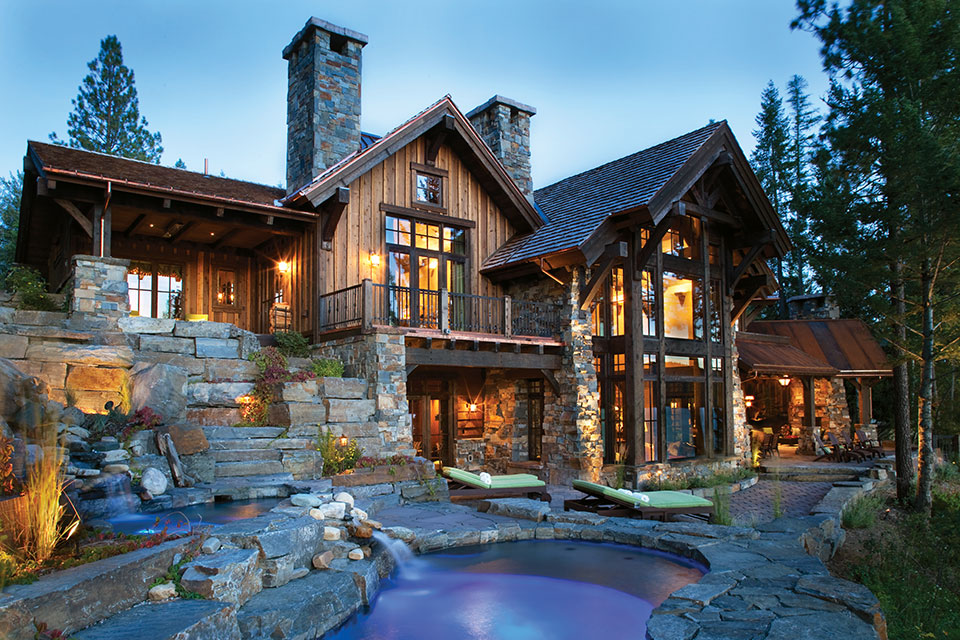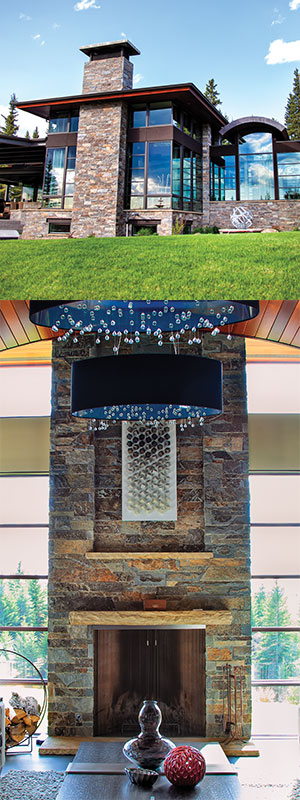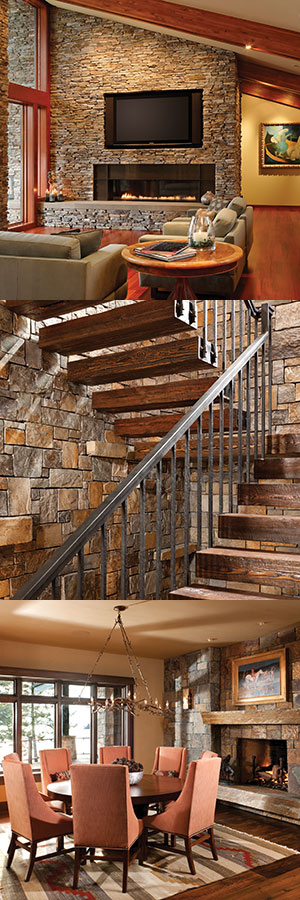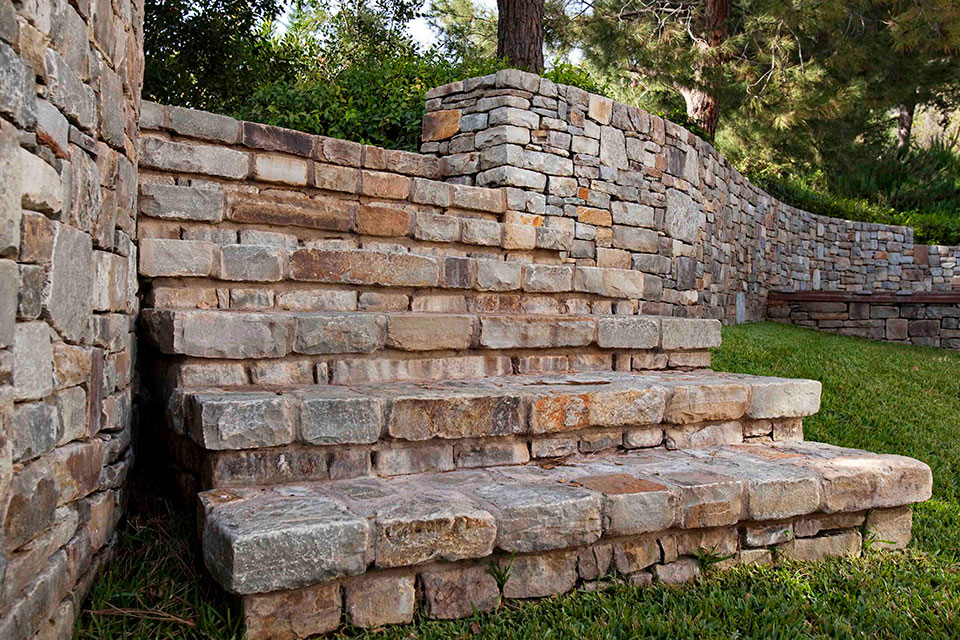Montana Rockworks provides stone for connecting a home with the surrounding land and to balance the nuances of design, as well as the skilled craftsmanship and exacting cuts that maximize each stone’s beauty and functionality.
Since forever, we have built our homes from rock and found artistic expression in working with the endless variations of stone. Stone is the most natural building material, and as design professionals recognize, it connects a home to the land and the greater environment. Because stone is formed by a unique geological history, each piece of stone is different and each tells a story. It is the nature of stone to reflect strength, stability, presence, texture, and subtle variety.
Professionals designing and building mountain homes recognize the importance of finding and using the right stone for their creative efforts, and they acknowledge how important it is to partner with rockworks professionals who can provide the stone they envision to implement the design. Their expectations for stone and the functions stone serves may vary by professions, but the commonality they share is recognizing how valuable a partner Montana Rockworks is in how they create and build.
Stone Offers Color, Texture, Dimension, and Massing
The Construction Perspective
Tyler Frank, a project manager with Malmquist Construction in Whitefish, offers his views on the role of stone in today’s home construction.
“Natural stone definitely brings a unique element to each of our projects,” says Tyler Frank, a project manager with Malmquist Construction. “Many of our projects use stone to capture the overall architectural feel of the structure, whether it is a rustic mountain home or a more contemporary design. Because the variations in stone attract interest, it often becomes the focal point. Stone captures your eye starting even before the home is in view. We use stone often at the entrance of the property and along the driveway leading to the home. The stone at the home’s entry and front façade provides color, texture, dimension, and massing to add to the curb appeal, and the landscape stone typically sets the tempo for what the house will look like because we enhance the impression that stone establishes with complementary surrounding building materials.”
Reflecting on the past use of stone versus how it compares to today’s approach, Frank comments, “Stone is used more in the design of luxury homes to signify the character of the home, and we use larger quantities of stone than in the past. As an example, stone typically was only used as a wainscot on the front of the home and the interior fireplace surround. Now, stone is being used on the home’s exterior, interior accent walls, countertop backsplashes, and even flooring. The application of stone has also changed over time, as our projects use stone not only for architectural purposes, but also structural ones.”
Tyler Frank finds that stone drives the overall design of a home. “When clients find a stone that they like, often times it dictates the siding product and color, roofing color, post and beam sizes, and many other architectural components of the home to create a well-balanced façade.” He notes that the native landscape in which the building is located may determine which stone is used on the project.
“I like the opportunities for artistic creativity when using stone,”
Tyler Frank comments when asked about trends for stone. “We are starting to see various blends of colors, sizes, shapes, and thicknesses of stone mixed together to capture the unique vision of the designer or owner. We have recently experienced larger areas of stone being used for a home’s massing as we bring the exterior stone walls through windows and continue it inside the home. For a more mountain modern style of home, we are seeing more rustic stone cut into specific shapes and placed in clean strategic patterns to create a contemporary format.”
The Montana landscape is another factor driving the increased use of stone. “Stone is one of the few building materials that connect the building with the environmental elements surrounding the structure,” notes Frank. “Here in northwest Montana, almost all our projects are built into a mountain hillside that has exposed natural rock outcroppings. We try to collaborate with the natural terrain and have our houses complement the natural landscapes surrounding the home.”
Beyond the aesthetic, practical considerations also support using more stone, and durability and low maintenance are always appealing features for building materials. Tyler Frank agrees. “With stone, you don’t have to worry about fading colors or a deteriorating product. Once the stone is placed on the building, you typically won’t have to touch the product ever again. Stone is also one of those products that seems to take longer to become outdated.”
The quality of stone is important to Malmquist Construction. “When choosing a stone supplier we look for someone who can provide us with a product that is clean, consistent, organized, and ready for install when delivered to the jobsite,” Frank explains. “As a natural product, it is difficult to have consistency in the color of the stone depending on where it was harvested in the rock formation at the quarry. It’s important for us to have a product that resembles the samples that were submitted to our client for approval. A quality supplier, such as Montana Rockworks, will do the preliminary work for us and provide a superior product delivered to the jobsite.”
Malmquist Construction | 406.862.7846 | malmquist.com
Stone Consistently Connects the Interior and Exterior
The Interior Design Perspective
Hunter Dominick, a noted local interior designer and owner of the design store Hunter & Company Interior Design, speaks about stone’s role in creating today’s interiors.
According to Dominick, current interior design relies on stone both structurally and as an important element for variations in design. “Stone plays a large role in the overall color palette, and at the same time, it plays a role as a structural element rich with a lot of texture and color. Because it is so visually intriguing, it can be used intentionally as a focal point or it can serve as background for other materials.”
Dominick has observed a shift in how designers use stone. “I feel it used to be that stone was the focal point. Whereas in the past few years, it has transitioned to be used more as a background material where its application creates a softer setting to accent interior and exterior architecture.” She adds that the selection of correct stone is critical to the direction of the interior’s design. “Stone definitely drives scale and dimensions, which affects other selections and completing the overall concept.”
With so many new materials on the market, it is interesting that the appeal of stone endures. Dominick explains, “It is because of the size and the texture of stone.”
“Everyone is drawn to the texture that a stone wall creates or the mass of large hearthstones.”
Stone is naturally grounding and a piece of our surroundings. Consequently, I find using stone is a great way to connect the interior and exterior in a consistent way. Stone is unique, and it is structural. With these qualities it will always have a connection to the earth. Also, stone is classic, and new materials will not compete with the look.”
“There has been a shift in the type of stone we use and how we apply it,” adds Dominick. “The contemporary look demands more clean horizontal lines. To accomplish this, we are using less moss rock and more ledger stone styles.”
In specifying and procuring stone, the right stone supplier is critical. “We ask, do they carry the style or the size of material that we are considering to create a certain look?” Because the answer is yes, Hunter & Company depends upon Montana Rockworks to source the right material.
Hunter & Company | 406.862.1402 | hunterinterior.com
Stone Serves as a Natural Architectural Finish
The Landscape Design Perspective
Johnny McDonald, ASLA, is senior designer with White Cloud Design, Inc., a full-service landscape planning firm in Whitefish. He offers his thoughts on the use of stone in landscapes.
When asked to consider how White Cloud Design uses stone in its landscape designs and plans, Johnny McDonald responds, “The role stone plays in our designs is wide and varied. We specify stone for a large variety of applications to meet our design concepts and site elements such as masonry grade, dry stack, flagstone, and also specialty pieces like benches, water feature walls, and even platforms for sculptures, to name a few of the many uses. The potential applications are infinite.”
McDonald agrees that the use of stone evolves. “In creating a variety of desired experiences, the role of how stone is used becomes unique to each project. Some are very organic and natural design intents, while others are organized and linear to meet a more contemporary vision.”
“We specify stone for a large variety of applications to meet our design concepts and site elements such as masonry grade, dry stack, flagstone, and also specialty pieces like benches, water feature walls, and even platforms for sculpture.”
“In our design world,” Johnny McDonald continues, “there is a mixture of factors that drive the stone selection. Rockworks and masonry is an art. Sometimes we have very specific details to meet and other times we leave a bit of flexibility to allow the craft and skill of the mason to show their unique skills and attention to detail. We are fortunate to have some very talented professionals with whom we work in northwest Montana.”
McDonald comments on how the shift to contemporary home design is affecting stonework, echoing comments by Hunter Dominick. “We are seeing trends towards more contemporary design in layout, function, and material finishes. This presents a challenge to suppliers to adapt their products to meet the specifications, and doing so at a cost that meets the projects’ budgets. There is a wide variety of sources for stone in our region and Montana Rockworks has grown and is known as the premier supplier in the region for superior products.”
“Most of our projects are in amazing natural settings and at White Cloud Design we are known for strong integration of the landscape design with both the environment and the architecture. The home’s exterior usually has natural stone as an architectural finish, so stone is the natural choice for landscape,” says McDonald, explaining why if the project scope and budget allows for stone, it is the preferred material. “If it is allowed, we almost always specify natural stone for its aesthetic, durability, and connection to the environments we design and create.”



